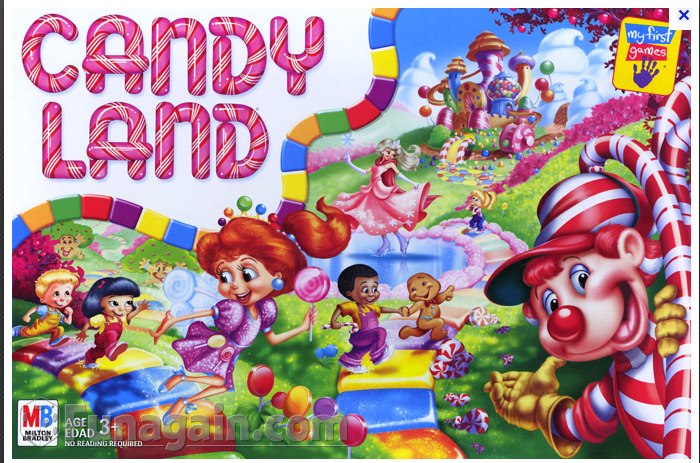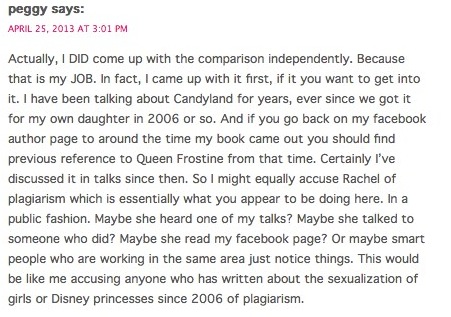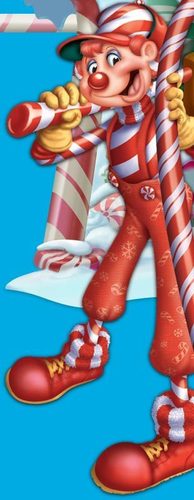 I am a fan of Peggy Orenstein.
I am a fan of Peggy Orenstein.
When I read Cinderella Ate My Daughter for my book club, I blogged about it (see here) and recommended it to friends and family. I found Orenstein’s indictment of the princess culture cogent and important, especially since I am the parent of a teenage girl.
I am also a fan of a blogger and writer named Rachel Marie Stone, whom I met last year when I was speaking at the Calvin Festival of Faith and Writing. That was the only time I have ever met Stone, but I was impressed enough by her to check out her blog and eventually to endorse her book, Eat with Joy. While poking around on her blog last year, I was particularly intrigued by her series of posts about the evolution of “skinny toys” — how toys like Strawberry Shortcake and Care Bears have slimmed down since I was a child in the late 1970s and early 1980s.
So I was disturbed this week when Stone contacted me to ask for advice about an odd development.
Stone pointed me to an excellent blog post that Orenstein wrote earlier this week about the game Candyland, in which she demonstrated to great effect how the game has transformed over the years. Characters who once wore overalls and were a little pudgy have become gorgeous—and highly sexualized. Orenstein has also just published an Atlantic article on the same topic.
Stone’s book editor, Al Hsu, observed in the comments to Orenstein’s personal blog that she had failed to give credit to Rachel Marie Stone’s blog post from 2012 on the topic of Candyland, which first posted the images that Orenstein used. He also raised the question of whether the ideas in Orenstein’s post were entirely her own. She defended herself most vociferously:
So let’s do a quick comparison of the posts and see whether it is possible that Orenstein came up with this idea entirely independently, as she claims in the comments, and was not at all influenced by Rachel Marie Stone’s 2012 writings.
1) Photographs. Orenstein suggests that after she had written her post, she Googled images of the game Candyland and used ones that popped up without attributing them to their original source. Unfortunately, this happens all the time with bloggers, and I’m afraid to say I’ve even done it myself, so I find it an entirely plausible explanation. When Orenstein discovered that the images belonged to Stone, she inserted an update in her post to acknowledge the source:
So, fair enough.
2) Language and ideas. There are no “smoking guns” in the language that Orenstein used in her blog post or the Atlantic article. I can certainly see a similarity of ideas, examples, and the order in which they appear. The similarities are striking, but in no way definitive; I don’t think they alone are proof of plagiarism. It is conceivable that two writers who were both working on issues around gender, weight, and childhood might both turn to pop culture for examples, and it is conceivable that they would come to similar conclusions. It’s not a big stretch to see that Queen Frostine now resembles a sexualized doll, as both writers point out.
3) Errors. This is where the plausibility theory begins to break down for me because of one thorny problem. Rachel Marie Stone made a factual mistake about the game Candyland when she posted her blog last year. She mislabeled a character named “Mr. Mint” (right) as “Mr. Candy Cane.”
There is no character named Mr. Candy Cane in the Candyland game. Stone never corrected this error on her blog post.
Orenstein’s blog post also refers to Mr. Candy Cane, which is an awfully big coincidence:
 If you Google “Mr. Candy Cane and Candyland,” the only direct references that appear are the post written by Rachel Marie Stone in 2012 and Peggy Orenstein’s writing from this week (which has been linked to many times). If you Google “Mr. Mint and Candyland,” you get thousands of hits.
If you Google “Mr. Candy Cane and Candyland,” the only direct references that appear are the post written by Rachel Marie Stone in 2012 and Peggy Orenstein’s writing from this week (which has been linked to many times). If you Google “Mr. Mint and Candyland,” you get thousands of hits.
What are the chances that both authors independently made the same silly mistake?
I hope that there is a viable explanation for this, but so far this week Orenstein has been adamant in her own blog comments and also in a Twitter conversation that all of the ideas in her post and Atlantic article were entirely her own and not influenced by Stone. In fact, she says she “might equally accuse Rachel of plagiarism” and suggests that perhaps Stone heard one of her talks on Candyland and then wrote about it.
At this point, I would say that the burden of proof rests with Orenstein to demonstrate that she did not copy any portion of Stone’s post, even though the use of Stone’s photos and the exact replication of Stone’s unique error don’t appear to support that claim. Perhaps Orenstein can lay these questions to rest by posting videos of the talks she says she has been giving on this topic over the last few years, links to bloggers’ posts who might have attended such talks and written about them, or evidence that there was a very good reason for calling that particular character “Mr. Candy Cane” other than that the stripey fellow does in fact resemble a candy cane.
I have not been able to turn up such evidence myself, but I so hope I am wrong about this. Unintentional borrowing sometimes happens with writers who read widely, especially in the age of the Internet. We don’t always remember what we’ve read and where it came from. I hope there is a reasonable explanation for how this occurred.
The image of Mr. Mint is from Fanpop.com.








